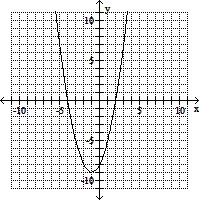Two sides and an angle are given. First, determine whether the given information results in no triangle, one triangle, or two triangles. Solve each resulting triangle.C = 35°, a = 18.7, c = 16.1
A. one triangle; A = 42°, B = 103°, b = 27.4
B. no triangle
C. two triangles; A1 = 42°, B1 = 103°, b1 = 27.4 or A2 = 138°, B2 = 7°, b2 = 3.4
D. two triangles; A1 = 103°, B1 = 42°, b1 = 27.4 or A2 = 7°, B2 = 138°, b2 = 3.4
Answer: C
You might also like to view...
Determine i) the domain of the function, ii) the range of the function, iii) the domain of the inverse, and iv) the range of the inverse.f(x) = 
A. f(x): D is all real numbers, R =  ;
;
f-1(x): D =  , R is all real numbers
, R is all real numbers
B. f(x): D =  , R =
, R =  ;
;
f-1(x): D =  , R =
, R = 
C. f(x): D = {x|x ? 2}, R = {y ? 0};
f-1(x): D = {x|x ? 0}, R = {y|y ? 2}
D. f(x): D is all real numbers, R is all real numbers;
f-1(x): D is all real numbers, R is all real numbers
Write as a decimal.365%
A. 36.5 B. 3.66 C. 3.65 D. 0.365
Find the vertex and the intercepts. Then graph the function.f(x) = x2 - 2x - 8
A. Vertex (- 1, - 9);
x-int = (-4, 0) and (2, 0);
y-int = (0, 8)
B. Vertex (- 1, - 9);
x-int = (-4, 0) and (2, 0);
y-int = (0, -8)
C. Vertex (1, - 9);
x-int = (2, 0) and (4, 0);
y-int = (0, -8)
D. Vertex (1, - 9);
x-int = (-2, 0) and (4, 0);
y-int = (0, -8)
Find the center and radius of the circle with the given equation. x2 + y2 + 14x + 10y = -25
A. Center (-7, -5), r = 7 B. Center (7, 5), r = 49 C. Center (-5, -7), r = 7 D. Center (5, 7), r = 49